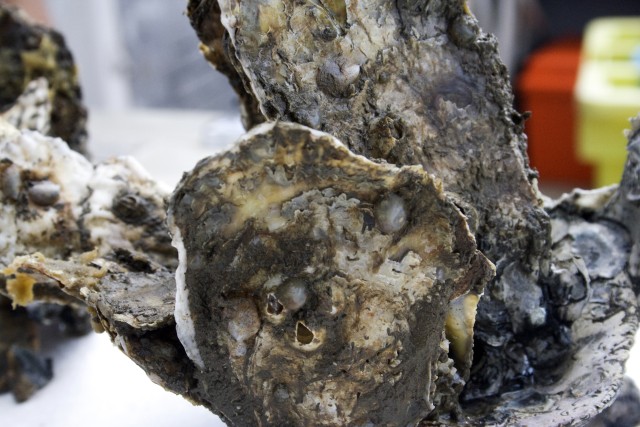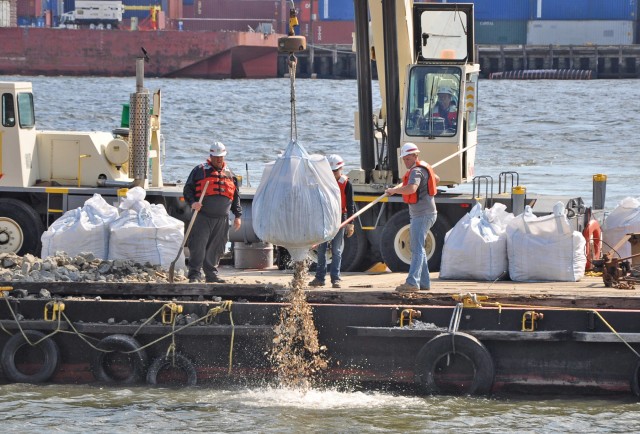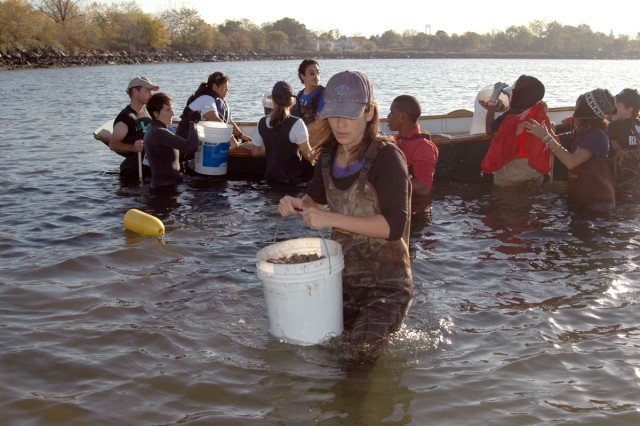BROOKLYN, NY -- Since the founding of the United States, military engineers have worked to ensure the waterways of the country are healthy enough to support maritime law enforcement, commerce, and recreation. Although engineers have had many partners along the way, one overlooked partner has received much attention recently for its success in clearing the water and stabilizing shorelines: The Eastern Oyster.
Although once found in abundance in the waterways of the northeastern United States, oysters have been hard hit by disease, over-harvesting, poaching, and polluted water. This has so devastated the oyster that the weakened population is no longer self-sustaining. The absence of oyster beds along with the stabilizing seagrasses they promote has caused rapid shoreline erosion in the northeast, which threatens local real estate, increases the cost of navigation channel maintenance, and potentially jeopardizes the fisheries industry. Sediments released through erosion smother remaining oyster beds, adding to the challenges facing their survival.
The North Atlantic Division of the U.S. Army Corps of Engineers is working with state, federal, and non-governmental partners throughout the region to help the keystone species of our northeast waterways make a comeback in three principal areas: the country\'s two largest estuaries - the Chesapeake Bay and the Delaware Bay - and the harbor estuary of New York City.
How oysters help
Oysters help water quality and management in two ways.
One, oysters build reefs. These reefs serve as a unique and safe habitat for a variety of fish, shrimp, crabs, and invertebrates, and also serve as natural breakwaters that absorb wave energy and provide a protected marsh area where marine life can thrive. This can ultimately lead to improved erosion control and improved fisheries.
Two, oysters filter feed, which provides two main water quality improvements. The first is to take plankton and particulates from the water column and deliver them to the seafloor where they are consumed by other marine life. The second is to circulate nutrients, which prevents the accumulation of such elements as nitrogen and phosphorus, which are the main nutrients in fertilizer and, when not circulated, can create dead zones in which no marine life can survive. The improved water quality from these two services allows more sunlight to penetrate to the seafloor, which allows seagrasses to grow, further stabilizing shorelines and further promoting marine ecosystems.
Focus Area 1: The Chesapeake Bay
Since the passing of the Water Resources Development Act 1986, the Division's Baltimore and Norfolk districts have been working with state and industry partners to construct substrate to establish sustainable breeding populations of native oysters. In constructing an oyster reef, substrate is the supporting foundation which provides vertical relief and a platform to which the spat (juvenile oysters) can attach. Fossil shell is the preferred, but scarce, substrate.
As part of an effort to develop a long-term plan for large-scale oyster restoration for the entire Bay, in 2009 the Corps also announced a 'native-only' strategy that ruled out non-native Asian oysters as a restoration alternative for fear that they would threaten the Chesapeake Bay's already stressed ecosystem.
Since 1997, Baltimore District has constructed 459 acres of reef habitat in multiple tributaries in the Maryland portion of the Chesapeake Bay. In the southern portion of the Bay, Norfolk District executed the Lynnhaven Ecosystem Restoration Project, which included 58 acres of oyster habitat and earned the Coastal America Partnership Award in 2009. Norfolk District also executed the Great Wicomico River oyster restoration project which was one of the world's largest restored oyster sanctuary reef network (85 acres). Most of the Chesapeake Bay reefs were constructed using dredged fossil shell.
The Chesapeake Bay Native Oyster Restoration Master Plan is being developed collaboratively by Baltimore and Norfolk Districts in partnership with the State of Maryland. It is being coordinated with several federal agencies and will identify tributaries most likely to develop sustainable populations of oysters with the implementation of large-scale reef construction, seeding, and other restoration activities.
In February 2011, many areas of the Bay reported the highest spat average since 1997.
Focus Area 2: The Delaware Bay
In the Delaware Bay, the Philadelphia District worked with the partners of the Delaware Estuary Program to initiate a shell planting program in 2005. From 2005-2008, the Corps worked with the Delaware Department of Natural Resources and Environmental Control, the New Jersey Department of Environmental Protection and others to plant almost 1.8 million bushels of clam shells - waste from local clam processing plants - on 1,044 acres of the bay. The shells provided a desirable clean, hard substrate for spat to attach to and grow and also alleviated storage and disposal costs to the clam companies, effectively turning a waste product into a useful commodity.
Studies of the $5 million program showed steady oyster bed improvements and, in 2008, oyster beds appeared to be stabilized.
In 2008, this oyster restoration program received the 2008 Coastal America Partnership Award given by the White House for successfully stabilizing the oyster beds of the Delaware Bay.
Focus Area 3: The New York Harbor Estuary
Oysters are a part of New York history. Before the last oyster bed was shut down in 1927, if someone said they were going to New York, it has been reported that the most likely response was probably "Enjoy the oysters."
Since 1927, oyster carts have been replaced by hot dog carts and "The Big Oyster" now goes by "The Big Apple." But through the Corps' leadership in the collaboratively developed Hudson River Estuary Comprehensive Restoration Plan, residents of New York can anticipate the restoration of this important natural resource by 2050. The intent is to restore habitats that will be preserved as sanctuaries.
The Comprehensive Restoration Plan, adopted by the Hudson Estuary Program and over 20 other partners, takes a broad vision for restoring a mosaic of habitats to the estuary. A panel of expert oyster scientists recommended that the best way to determine the feasibility of restoring oysters to their historic numbers was to build several experimental small-scale reefs in a natural environment where they are exposed to predators and other biological and physical interactions, and observe their development. This approach of optimizing the scale has proven to be successful in the Corps' oyster restoration efforts in Chesapeake Bay.
If deemed feasible, the Corps will construct reefs at five locations (with about 5,000 shells set with spat for each site) and provide vessel and team support to assist in data collection.
The Army Corps of Engineers New York District's ongoing two-year placement of spat and reefs addresses the questions of where and how sustainable oyster populations can be reintroduced in New York Harbor and the lower Hudson River.
The Corps' cohesive collaboration with the various entities working on the program seeks to be able to provide important information that will guide policy makers in decisions affecting the conditions of the harbor and river far into the future.
The various partnerships as well as the news of increasing spat numbers - and possible disease tolerance - are encouraging. But oysters aren't out of the muck yet. Federal, state, academic and industry programs must continue for several years, even through tough economic times, before results can be labeled as bona fide. And before New York can once again be called the Big Oyster.
Related Links:
Lynnhaven Oyster Restoration project






Social Sharing